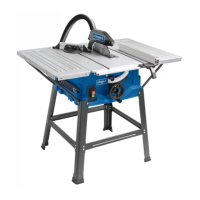www.scheppach.com
34
|
GB
Safety instructions for the operation of circular
table saws
a) Switch o the circular table saw and discon-
nect it from the power supply before removing
the table insert, changing the saw blade, im-
plementing settings on the riving knife or the
saw blade protective cover, and if the machine
is left unattended.
serve to prevent accidents.
b) Never leave the circular table saw running
unattended. Switch o the electric tool and
do not leave it until it has come to a complete
standstill. An unattended running saw poses an
uncontrolled risk.
c) Set up the circular table saw in a location that
is level and well ventilated, and where it can
stand safely and remain balanced. The instal-
lation site must provide sucient space for
easily handling the size of your workpieces.
Disorganised and unlit working areas, and uneven,
d) Regularly remove chips and sawdust from be-
neath the saw table and/or from the dust ex-
traction system. -
mable and can self-ignite.
e) Secure the circular table saw. If a circular table
f) Remove the adjustment tools, wood residues,
etc. from the circular table saw before switch-
ing it on.
dangerous.
g) Always use the right size of saw blade
and an appropriate location hole (e.g. dia-
mond-shaped or round). Saw blades that do not
of-centre and result in a loss of control.
h) Never use damaged or incorrect saw blade
mounting materials, such as anges, washers,
screws or nuts. These saw blade mounting ma-
i) Never stand on the circular table saw and do
not use it as a step stool.
-
c) Never hold and push the workpiece against the
turning saw blade during sawing. Pushing the
workpiece against the saw blade during sawing
d) Align the stop rail parallel to the saw blade.
A stop rail that is not aligned will push the work-
piece against the saw blade and create kickback.
e) With concealed saw cuts (e.g. folds, grooves
or slits in the turning process), use a thrust
collar to guide the workpiece against the ta-
ble and stop rail.
able to better control the workpiece in the event
of kickback.
f) Apply particular caution when sawing assem-
bled workpieces in areas that are not visible.
could cause a kickback.
g) Support large panels, in order to avoid the risk
of kickback due to a jammed saw blade. Large
-
hang the table surface.
h) Apply particular caution when sawing work-
pieces that are twisted, knotted or warped, or
that do not have a straight edge that can be
used to guide them with a mitre stop or along a
stop rail. A twisted, knotted or warped workpiece
is unstable and results in incorrect alignment of the
i) Never saw multiple workpieces stacked on top
of each other, or one behind the other. The saw
blade could engage in one or more parts and result
in kickback.
j) If you wish to restart a saw, the saw blade of
which is inserted in a workpiece, centre the
saw blade in the sawing gap so that the saw
teeth are not hooked in the workpiece. If the
cause kickback when the saw is restarted.
k) Always keep saw blades clean, sharp and suf-
ciently set. Never use warped saw blades
or saw blades with cracked or broken teeth.
-
ming, blocking and kickback.

